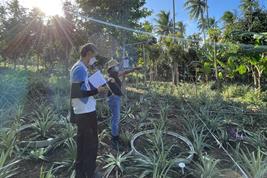28.04.2025

In the journal Smart Agricultural Technology, researchers from the Leibniz Centre for Agricultural Landscape Research (ZALF) have presented a newly developed sensor that makes it much easier and cheaper to monitor plants in the field. The device measures NDVI - an index of photosynthetic activity and plant vitality - and is aimed at research teams that often lack the financial means to purchase expensive measuring equipment. The sensor costs less than €250, can be automated and has been developed and tested in collaboration with scientific partners in Benin and the Philippines.
NDVI stands for "Normalized Difference Vegetation Index" - a value calculated from the reflection of visible (red) and near-infrared light. The higher the NDVI, the greener and more active the vegetation - a sign of plant health and growth. A low NDVI value indicates sparse vegetation or stress, such as drought.
Until now, the most common NDVI instruments have been commercial and very expensive. These are available either as flexible, portable handheld devices that require manual operation, or as automated, stationary systems that operate without direct user input, but for a survey, for example, require the simultaneous use of multiple devices to cover different areas. "Our goal was to develop an affordable and automated solution for research, especially in places where expensive technology is often unavailable, such as parts of Africa or Southeast Asia," said
Reena Macagga, lead author of the study.
The team developed two versions of the sensor - one portable and one that automatically collects data in the field. Both can be built from readily available components, are easy to program and have been successfully tested in different climates. Once calibrated, the device provided measurement results comparable to those of a commercial reference instrument.
Better understanding of plant development and environmental responses
The new sensor enables NDVI to be measured with high temporal resolution, i.e. several times a day over long periods of time. This will enable researchers to more accurately track how plants in field trials - for example, under different cultivation or fertilization strategies - develop during their growth cycle, when crucial stages such as leaf formation, the onset of flowering or ripening occur, and how environmental factors such as drought or nutrient deficiency affect these processes.
Such information is crucial for investigating the resilience of different crop varieties to environmental stress, or for assessing the impact of agricultural practices such as fertilization or irrigation. The sensor can also be used to document seasonal changes or to conduct comparative trials in different regions.
Sensor-based research worldwide
Thanks to its automated and low-maintenance data collection, NDVI measurements can now be carried out in remote locations or in difficult conditions, such as tropical regions with high humidity. This greatly expands the possibilities for field-based research.
The sensor is part of a wider series of developments at the
Working Group Isotope Biogeochemistry & Gas Fluxes at ZALF aimed at creating affordable and adaptable tools for measuring CO₂, water and vegetation data. The aim is to enable hands-on research in regions where expensive technology has been unavailable.
"We want to democratize science," says Dr. Mathias Hoffmann. "Our developments aim to make high-quality field research possible - even on a small budget and anywhere in the world."
Projektpartner:
- Leibniz Centre for Agricultural Landscape Research (ZALF), Germany
- Humboldt-Universität zu Berlin
- University of the Philippines Los Baños
- University of Abomey-Calavi (Benin)
Further Information:
Link to the original publication:
https://linkinghub.elsevier.com/retrieve/pii/S277237552500125X
Funding:
This work was supported by the German Federal Ministry of Food and Agriculture (BMEL) under grant number 2819DOKA06. Geoffroy Sossa also received support from the West African Science Service Center on Climate Change and Adapted Land Use (WASCAL), the Prince Albert II of Monaco Foundation, and the International Foundation for Science (IFS, grant no. I-1-C-6642-1).
Text disclaimer:
This is a summary of the original publication generated with the assistance of artificial intelligence: Macagga, R., Sossa, G., Ayaribil, Y., Bayot, R., Sanchez, P., Augustin, J., Bellingrath-Kimura, S.D., & Hoffmann, M. (2025): A new, low-cost ground-based NDVI sensor for manual and automated crop monitoring. Smart Agricultural Technology, 11, 100892. https://doi.org/10.1016/j.atech.2025.100892, published Open Access under the license CC BY 4.0 https://creativecommons.org/licenses/by/4.0/.
The text has been carefully reviewed and edited in accordance with the AI guidelines of ZALF.
